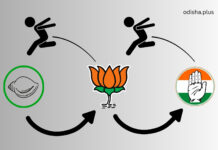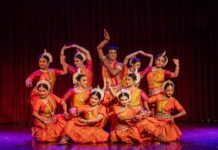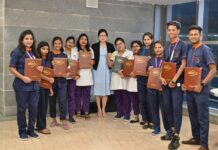Kapilas Bhuyan

Osakothhi, a living tradition of mural paintings and performances of music, singing, dance and trance is unique to South Odisha, particularly the erstwhile Ganjam district. A few years ago I had an exciting trip to South Odisha. I had accompanied my artist friend Ramahari Jena to his village Ghatakuri in Ganjam district.
Ghatakuri, a small village is located at the outskirt of Aska town, famous for its Sugar factory. By the time we reached in his village it was a bit earlier than the lunch time. My friend got engaged in exchanging family topics with his relatives, and I, falling short of what to do, went out for a stroll in the village to kill my time. While doing so; on the bending of the road at a corner of the village, I came across the drawings of colourful figures being drawn on a wide mud wall of a house. The drawings were of very raw quality and the use of colour was crude. However, the overall look of wall-painting had a magnetic pull inherent in it. It was characteristically a rural mural painting.

The figures were of religious nature; like the Kali, Durga, Mangala, Shiva and Parvati etc., and were drawn on separate well-defined sections amidst figures of people, animals and various familiar objects being used or associated with in our daily life. And a boat was being drawn at the base of the whole painting as if holding all of it. As I enquired what it was, Ramahari informed me that it was Osakothi, being worshiped upon a vow to fulfill a personal desire by someone involving village community.
After my return, when I wanted to know more about it there was virtually nothing available on the internet. As I had gathered, the famous Painter, Art Historian and Litterateur Dr. Dinanath Pathy has co-authored the only book on the Osakothi painting tradition, titled ‘Murals of Goddesses and Gods’ with Dr. Eberhard Fischer which was published by Indira Gandhi National Centre for the Arts (IGNCA), New Delhi and Museum Rietberg, Zurich, and the book was largely unavailable in Odisha.
What is Osakothi?
As I got to know from Dr. Dinanath Pathy, who was then alive that, Osakothi is an alternative worshiping of Devi by the rural agricultural community, and being held for five, seven, fourteen or twenty-one days depending on the financial capacity of the devotee during the month of Ashwina-Kartika in rural Ganjam.
Osakothi tradition is considered as a fertility festival as people those who keep the vow to organize it, they normally had it in their mind to be blessed with offspring. Besides, since the worshipping time coincides with the new cultivation season, 21 types of seeds are put on soil on a ‘Kula’ or bamboo separator those sprout during the time period.

How the Osakothi ritual is being observed?
“Each evening the villagers gather before the mural, and worship with incense and camphor. There suddenly appears a person in the garb of a woman very dramatically, and after bowing before the central deity of Ma’ Mangala gets into a trance – gradually when he gets to the peak, he dances to the tune of Dhana-Koila (an improvised earthen drum) and the rhythm of the singing of the Gauni (village singer) – at this juncture people in the gathering asks him various questions concerning their own wellbeing and fulfillment of their desires to which he goes on answering”, Dr. Pathy had informed for my enlightenment.
Normally a group of rural artists are commissioned to paint the empty wall meant for Osakothi at the village Kothaghara or at any other suitable place. The Osakothi starts with erecting a sanctified pole or ‘Subhakhamva’ at the place selected for the ritual hoisting a red flag at the pinnacle that furls with the wind. This auspicious pole is generally equated with the Jarjara as sanctioned by Natya Shastra which keeps the evil forces away from the sanctified space meant for theater performances.
It is very interesting to note that Osakothi is a participatory ritual by all the communities of the village. Although a particular household takes the initiative to organize it for the fulfillment of a desire, almost all the households across communities contribute for the celebration.

Though the primary attraction of Osakothi celebration is mural paintings on the empty wall, singing, dancing and getting into trance are integral part of the ritual practice. The lines with twig-brush are gaudy, yet unique.
“There is a lyrical grace in the rhythmic rendering of lines. This is known as Gara Banaka. Though Osakothi painting is linear, the colour application or Ranga Banak is an important aspect. The painters after delineating the basic structures of the figures take to laying colours. They are neither hesitant nor flattered while selecting the definite shades for different motifs. They choose bright colours like ultramarine, deep cadmium yellow, vermillion, viridian green and black. And sometimes pink is a favorite colour of the artists. They don’t mix shades. When all the shades are applied, the canvas looks very full and delighting”, explained Dr. Pathy for my understanding.
With a close look at the murals, I could observe that there was a lair of mud defacing the figures on the Osakothi murals of Ghatkuri village – why was it so? Dr. Pathy had his explanation to this that, it could be symbolically immersing the deities of Osakothi mural by smearing white on it, and smearing mud might have been an alternative for the purpose. This process from creation to immersion of a rural practice, today, apart from being an enriched painting tradition, no doubt, looks very modern to me.
(The author is a Senior Journalist & National Award winning Filmmaker)





















